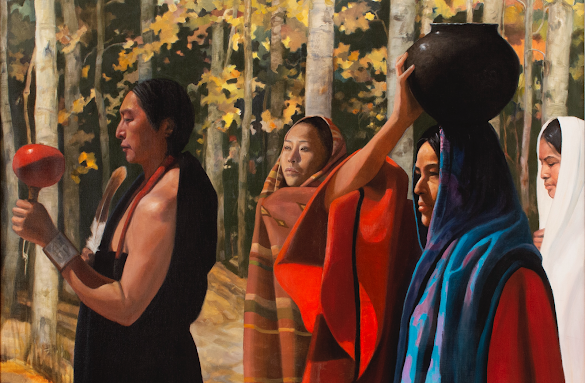When asked recently what was my favorite art period. I didn't hesitate. It was the very dynamic period from mid-19th century to the pre-WW 2. Perhaps because with the invention of the camera, artists were free to move from photo-realism to Impressionism, Japonisme, and Pointilism. So many new techniques arose in that period and have endured to this day.
It was seeing the famous painting by Georges Seurat (1859-1891), "Sunday Afternoon on the Island of the Grande Jatte" that the magic and science of Pointilism struck me. Close up, the painting is a mix of colored and indistinguishable dots, but as you move back, it becomes an outstanding representative scene. (Below is the painting at a closer view)
How do they manage to paint small areas of color or tones and yet create a portrait or a scene? It baffles me at the same time it creates a certain wonder.
(click on images to see an enlarged version)
By 1886, Seurat and Paul Signac (1863-1935) had mastered the technique and are considered to be the Pioneers of Pointilism. It was the optic science of the eye that blurs the overlapping dots into a single object. Today, we use the same optics for digital creations via pixels.Back then, it was mixing primary colors to create secondary colors.
Other well known artist who experimented with Pointilism were Van Gogh, Monet, Pissarro, and Luce.Well, enough about the technique. Here's some of the more famous paintings as seen using optic science.
In this Seurat painting, you can see the dots at the very closest. At you move back, the blurring starts and the man begins to take shape in our vision.
Here is a closer view of the painting "Sunday Afternoon on the Island of the Grande Jatte." (shown above at a greater distance.)
The other pioneer of the technique, Signac, made expert works. For this blog, below is a close-up of his Pointilist technique followed by a bit of softening, which the eyes do naturally as the colors begin to meld together.
Lastly, although Vincent Van Gogh was known more for his impasto works, here's one that shows his interest in Pointilism:
This technique is carried into contemporary times by artists like Chuck Close (1940-2021), who not only uses colors for his large portraits, but also black/white tonals to accomplish the same effect. He's successfully creates the blurring within tiny rectangles.


















